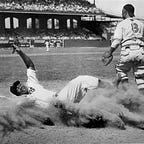Oliver “Ghost” Marcelle: Thoughts on The Long Gone.
Must have been hotter than hell,
he had to get out of there.
Had to get out of Louisiana,
and had to get out of his own mind.
That’s all I could think about when I read up on Oliver Marcelle. It’s all I could picture when I was scouring books for stories about his career and it’s all I could think of when reading about his temper and the tragedy of him getting in his own way.
I just imagine that whether he knew it or not, he was running from something. Maybe he was running from his past in Louisiana, a hard life, or maybe just from personal demons, running from himself.
In the great theatre of this game of baseball, Oliver Marcelle is flawed but brilliant. His flaws seem to be the characteristics that make him stand out, this is new for me in the context of these Negro Leagues because most of the other players I have examined are cast in a more heroic or even stoic light.
Oliver Marcelle was born sometime between 1895–1897 in Thibodaux, Louisiana, he was the fifth of six children raised by a single mother, I don’t imagine life was very easy but he made his way. I don’t think there is any question that he had to fight to get to where he was going and by 1914 he was playing semi-pro ball for the New Orleans Black Eagles. He was soon to make his professional debut up north with brief stints for the Brooklyn Royal Giants and Hilldale Daisies in 1918–19. In 1920 he joined the Atlantic City Bacharach Giants where he would truly begin to make his mark on the game and become known as an important member of the “million-dollar infield” mentioned in one of my previous write ups about Dick Lundy. This incarnation of the infamous infield included the likes of, Frank Warfield at second , Jud Wilson at first, and Dick “King Richard” Lundy playing short.
At third base, Oliver was seen as a formidable force, possibly the best of the decade. He played fast and smart, allowing little if anything to get past him at the hot corner. With a bat he wasn’t bad either, from 1921–28 his batting averages looked a little something like this — 305, .364, .295, .343, .308, .255, .306, and .296. Along with his time in the Negro Leagues, there were several successful winter seasons spent in Cuba where he again produced staggering offensive numbers, ending with a .305 average. He played with the Bacharach Giants in the 1927 Negro League World Series, and in a 1952 Pittsburgh Courier poll, was voted all time best third baseman over hall of famers Judy Johnson and Ray Dandridge.
Off the field, trouble followed “Ghost” closely. In May of 1925, Marcelle was involved in a barroom fight in which his teammate, Dave Brown, shot and killed a man. Marcelle and another teammate were questioned by police but surprisingly let go, but this sort of trouble was always lurking around the bend. There was even an incident in which he clubbed hall of famer Oscar Charleston in the head with a bat during an on field argument. The pinnacle of his troubles came in 1930 while playing winter ball in Cuba, a disagreement over a dice game led to another violent altercation in which Marcelle had a large portion of his nose bitten off by teammate Frank Warfield, insanity.
This was sort of it for Marcelle, he wouldn’t ever mentally recover from this injury.
He began to wear a black patch over his damaged nose but as James A. Riley puts it,
“Oral accounts indicate that this incident was indirectly responsible for his withdrawal from league play because Marcelle, a vain man, could not endure the “ragging” from fans and opposing players about his appearance.”
He retired from baseball in 1934 and became a house painter in Denver, Colorado. His end wasn’t a happy one and it makes me too sad to think about. So many great players made mistakes in their lives and I won’t try to justify any of them, but there is real tragedy in dedicating your life to a game that you love and then having to leave this world thinking you haven’t proved your mettle.
Sources
Only The Ball Was White: Robert Peterson
The Biographical Encyclopedia of The Negro Baseball Leagues: James A. Riley
Oscar Charleston; The life and Legend of Baseballs Greatest Forgotten Player: Jeremy Beer
